 Astronomy Honors
Astronomy Honors
 Astronomy Honors
Astronomy Honors
| |
|
|
|
Most of the effort toward galaxy classification in this century has consisted of studying photographic images of galaxies by eye. The dominant paradigm is one established by Edwin Hubble (1936), and later refined by Alan Sandage (1961). This classification is referred to as the Hubble Sequence. There have been many subsequent variants, but largely the classification has been based on subjective, qualitative assessments of the distribution of optical light -- what is often referred to as 'galaxy morphology.' There are many problems with the approach, yet it has remained paramount for over 70 years. Some astronomers have realized that categorizing galaxies by their spectra, as was done for stars, might provide an alternative, and possibly more quantitative and physically insightful method of classification. The most notable, and pioneering effort was by W. W. Morgan, at Yerkes Observatory (Morgan & Mayall 1957). Not coincidentally, it was Morgan who quantified and developed the stellar spectral classification scheme you used in Lab #3 (Spectral Classification of Stars).
Ultimately, the value of a classification scheme is its utility. To understand this, one must ask for what purpose, or application is the classification being done? As we will see, there are times when one might want to classify by morphology, and others when using spectra are the only sensible way to proceed.
In this lab you will become expert galaxy classifiers by both methods -- morphology and spectra. You will devise your own classification schemes based on nearby galaxies, and test them against real data. Finally, you will assess which of these two methods might be the most useful in classifying galaxies at the farthest reaches of the universe.
Your first task it to take these 9 images and sort them, by eye, according to some criteria which will become your classification scheme. The goal here is to have a sequence of objects that will form a reference. Using this sequence, in Section 3 you will attempt to classify other galaxies by asking where they best fit in the sequence. Think ahead a little bit here. Since no two galaxies are identical, when you classify other galaxies by comparing them to your reference sequence, you will have to estimate whether they are closer to one 'type' or another. Often they will fall in-between. There may be times when you think a galaxy is extreme, i.e. lies beyond, or outside the range of your reference sequence. Your reference sequence should be designed to allow you to do make these assessments.
Your reference sequence should be one-dimensional, that is, a linear sequence where you line them up in a row. In principle, you might come up with a two-or-more dimensional grid, where you would have several sequences. However, for the current exercise, design a one-dimensional sequence to simplify comparison with results below. Note that your sequence need not have 9 separate categories if you do not think you can tell the difference between some of the galaxies. In other words, you can lump galaxies together into one group, or 'type,' if you feel that distinguishing between them is not warranted.
Try to forget what you have been taught about the Hubble classification scheme. Be creative and realize there is no 'truth,' only utility. Here, the utility here will be how well you can classify other galaxies.
View the montage of images as displayed on this page or click on [B]=big, [S]=small, or [N]=negative images in pop-up windows. You can arrange these pop-up windows with your cursor to form your classification sequence. On the MACs in 5517 you may find the pop-up windows cumbersome; they will take time to load and the screens are somewhat small. You can resize the pop-up windows by clicking on their lower-right corner and dragging the corner to the desired size.
NGC 2775
[B]
[S]
[N] 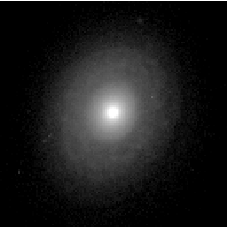 |
NGC 2903
[B]
[S]
[N]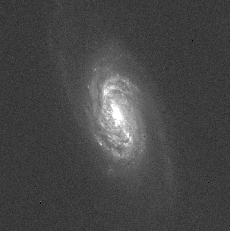 |
NGC 3077
[B]
[S]
[N]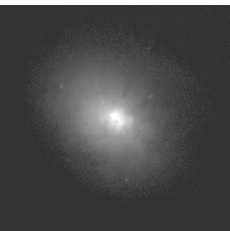 |
NGC 3147
[B]
[S]
[N] |
NGC 3368
[B]
[S]
[N]  |
NGC 4406
[B]
[S]
[N]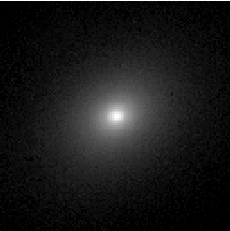 |
NGC 4449
[B]
[S]
[N]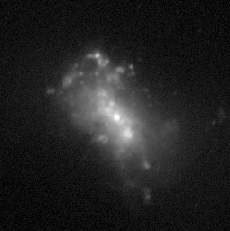 |
NGC 4559
[B]
[S]
[N]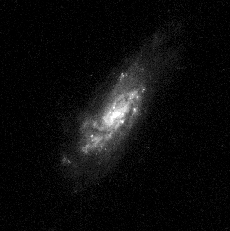 |
NGC 5248
[B]
[S]
[N] |
|
Q1: In your lab book, draw sketches of your reference sequence. This
should be a diagram that defines your classification. Be sure to
indicate which reference galaxies belong to what stage in your
sequence. The 'NGC' labels above each image are catalogue names that
can be used for identification. Devise a labeling scheme for reference and for later classification. When choosing the labeling scheme, keep in mind that you will have to define a classification for other galaxies that might not exactly be in one category or another. Summarize the criteria you have chosen to order your reference sequence. What are the trend(s) along the sequence? The more careful and specific you can be here, the better you will be able to classify galaxies in the next section. Do you think the trends are physical -- do the represent true physical differences between the galaxies? Or are some of the trends apparent -- do they represent differences in the way you have observed physically similar galaxies? For example, did you choose elongation as a classification parameters? If not, comment on why you did not choose this attribute.
|
The spectra are plotted as log(flux) versus wavelength (in Angstroms). The log scale on the y-axis allows you to see the often large changes in flux from wavelength to wavelength. The flux scale (y-axis) has been arbitrarily set to 1 (log(flux) = 0) at 5500 Angstroms.
As you are classifying these spectra, you won't be able to identify the elements responsible for the emission and absorption lines. For reference, then, note the approximate wavelengths of the key features you are using to classify. No doubt you will want to note if the features are in emission or absorption. Again, keep in mind that your sequence need not have 9 separate categories if you do not think you can tell the difference between some of the galaxies' on the basis of their spectra.
NGC 2775 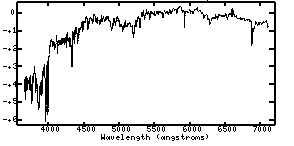 |
NGC 2903 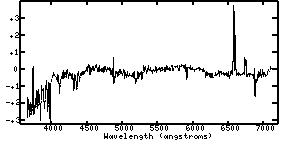 |
NGC 3077  |
NGC 3147 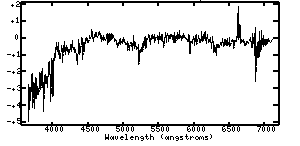 |
NGC 3368 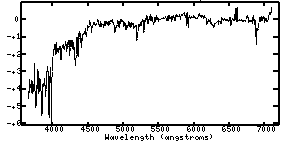 |
NGC 4406 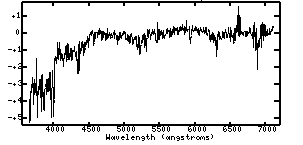 |
NGC 4449 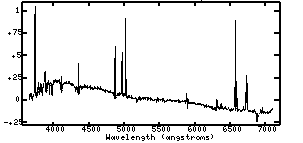 |
NGC 4559 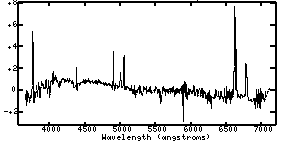 |
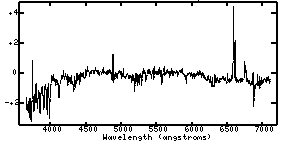 |
|
|
Q2: Construct a spectral classification sequence, noting key spectral
features for each point in your classification sequence. Comment on whether you think there is more or less likelihood of this classification representing true physical differences in the galaxies. For example, if you viewed a spiral galaxy from different angles, what do you think would change more: it's visual appearance (morphology), or its spectrum? Recall that in Lab 3 the spectrum of a star allowed you to identify what kind of star it was. Knowing this, what can you infer about the content of a galaxy from its spectrum? Can you make as direct an inference about the content of a galaxy from its morphology?
|
|
Q3: Compare the two classifications: morphological (Section 1), and
spectral (this section). Do this by ranking the 9 galaxies,
independently, in order for each sequence. You might present this as a
two column table. Comment on how well the two methods compare. Does one scheme seem better able to distinguish between this set of galaxies? Do you think one scheme might be more accurate or quantifiable than the other?
|
|
Q4. Classify the galaxy NGC 3623 via its image and spectrum.
Which method provides a better classification?
Define what you mean by 'better.' For example, was it easier
to identify a corresponding reference type in one classification
sequence rather than another?
|
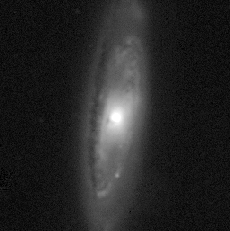 |

|
| Q5: When you are done, ask your
instructor to identify which galaxies in your reference sequence have
the most similar Hubble type. How well did you match up NGC 3623 to galaxies of comparable Hubble type for your two classification schemes? Did one scheme work better than the other? Explain what you expected.
|
Next, try four other galaxies, some of which are more distant than
those you examined in Section 1. The images here are based on
photographic plates which, in this case, have coarser spatial sampling
than the CCD images. These two effects (greater distance and poorer
sampling) combine to make the images less well resolved, i.e. more
blurred and coarser. Another effect of the photographic plates is that
they have less dynamic range than the CCD images in Section 1. In
other words, it is not possible for the photographs to record the
faint, outer parts of the galaxies as well as the bright cores, or
vice versa. In these images the cores appear to be 'burned out,' or
saturated.
| Q6: Classify these 4 'mystery'
galaxies (A-D) via their images alone. What systematic consequences
might the above effects have on your morphological classification? For
example: how important was it for you to see the structure in the
center of the galaxy images? Similarly, how important was the fine
detail (the 'morphological filigree') in your classification? Do you
think you can see comparable detail in these images as in the CCD
images above?
|
A 
|
B 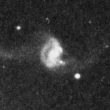
|
C 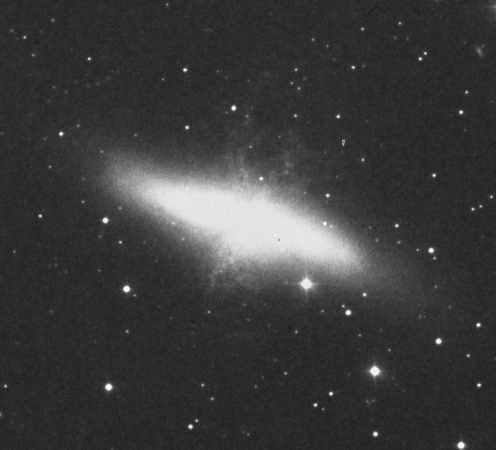
|
D 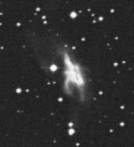
|
| Q7: Classify these same 4 'mystery'
galaxies via their spectra alone. The galaxies are intentionally given
different labels here, 1-4. Are the spectra of comparable quality
as the ones you used in Section 2 for your spectral classification?
|
1 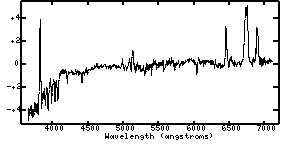 |
2 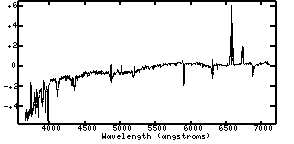 |
3 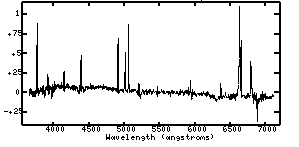 |
4 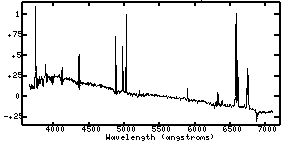 |
| Q8: Make your best estimate of
matching A-D with 1-4. Estimate (very roughly) on the reliability of this
matching. You might base this, for example, on how closely the
reference galaxies lined up when ordered in both classification
sequences. Show your results to your instructor and have him/her give you the correct matches. Did you do as well as you expected?
|
| Q9: Comment on whether you feel
the spectral or morphological classification is more meaningful or
reliable for these 4 galaxies. In this context, a 'meaningful'
classification is one where there were reasonably close counterparts
in the reference sequence. After all, if an object falls outside of a
classification sequence, how do you classify it? 'Reliable' here
addresses the issue of whether the images or spectra are of comparable
or sufficient quality to compare unambiguously with the reference
sequence. For example, if the images were too faint to see the galaxy,
it would be difficult to assess its morphology. Does it make more sense to use one classification scheme here over the other?
|
The galaxies in this image are known lie over a wide range of distances. Some of the galaxies are at the largest distances ever measured (over 10 billion light years). This means that we are seeing them at a time when the Universe was very young. Imagine that you are interested in determining if there were galaxies at those great distances (early times) similar to the ones we see nearby (today). Assume you know the distances to many of the galaxies (we'll figure out how, in the next Lab), but now you have to figure out a way to compare 'apples to apples.' How would you do it? Would some form of classification be useful?

| Q10: Can the majority of
galaxies be sensibly classified based on their images? Would you
expect spectra might be more useful? Argue for or against using
spectral classification in this context.
|
| |
|
|
|